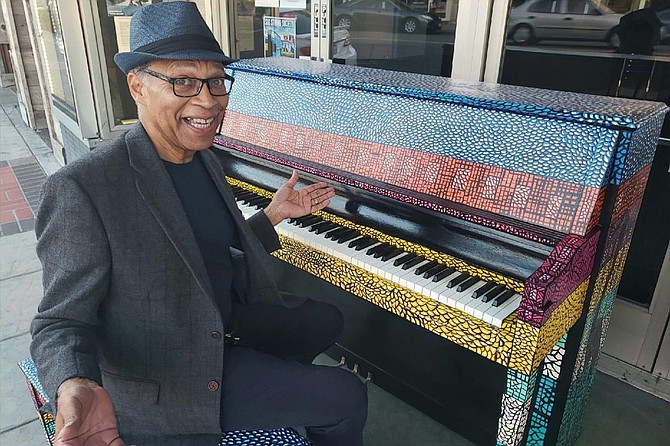 Facebook
Facebook
 X
X
 Instagram
Instagram
 TikTok
TikTok
 Youtube
Youtube

“I guess I am the force behind the Oceanside Art Piano Project,” admits musician Robert Parker, about the intricately hand-painted piano that now calls the Oceanside Museum of Art its home. “But it’s a collaboration [with] the Oceanside Cultural Arts foundation with primary influence from Kenneth Rexrode’s The Piano Project that collects donated pianos and places them in schools and public places around the county. They attracted the donor, and Kenneth’s project manager Kim Paige arranged for delivery. It couldn’t have happened without them.”
Another key contribution is the hand of local artist Rene Cosby. Where did Parker get the idea for this collaboration?
“I was inspired by Play Me Again pianos in Atlanta,” says Parker. “I made the proposal and I sold the idea to Rene, because I believed it might help launch her career to create Oceanside’s first public painted piano. I’m a big supporter of public pianos, and Kenneth is a natural ally. I didn’t necessarily envision these as painted instruments until I saw a video from Play Me Again.”
“I was already a big fan of Rene’s art before I approached her. I fell in love with the intricate work she does. She agreed to donate her labor, which was awesome because she put in over a hundred hours on the instrument we found. She finished just in time for our inaugural concert at the end of September.”
So what kind of considerations go into acquiring an instrument for public use?
“Because we are going to be transporting it all around town, I knew we needed a lightweight instrument, and we found this studio spinet that’s relatively easy to move, although it still weighs about 500 pounds.”
A lot of these pianos I see on the street on videos appear pretty beaten up. What’s different about this one?
“The piano we found is a really fine instrument,” says Parker. “It’s not a ‘beater.’ It was actually a gorgeous instrument before it was painted, but Rene really transformed it, and the result is stunning.”
How does it sound?
“The tone is so balanced. It’s beautiful. The action and mechanics are superb. Any pianist who plays it will recognize that it’s a quality instrument.”
“We plan to move it around the city, but only for one day, because we don’t want to leave it outside anywhere overnight. I don’t want it to swell or let the salt air affect it. We have several professional movers and tuners that we rely on to transport it and keep it in top shape. A lot of us work for free or at a reduced rate, so it’s kind of like a family.”


“I guess I am the force behind the Oceanside Art Piano Project,” admits musician Robert Parker, about the intricately hand-painted piano that now calls the Oceanside Museum of Art its home. “But it’s a collaboration [with] the Oceanside Cultural Arts foundation with primary influence from Kenneth Rexrode’s The Piano Project that collects donated pianos and places them in schools and public places around the county. They attracted the donor, and Kenneth’s project manager Kim Paige arranged for delivery. It couldn’t have happened without them.”
Another key contribution is the hand of local artist Rene Cosby. Where did Parker get the idea for this collaboration?
“I was inspired by Play Me Again pianos in Atlanta,” says Parker. “I made the proposal and I sold the idea to Rene, because I believed it might help launch her career to create Oceanside’s first public painted piano. I’m a big supporter of public pianos, and Kenneth is a natural ally. I didn’t necessarily envision these as painted instruments until I saw a video from Play Me Again.”
“I was already a big fan of Rene’s art before I approached her. I fell in love with the intricate work she does. She agreed to donate her labor, which was awesome because she put in over a hundred hours on the instrument we found. She finished just in time for our inaugural concert at the end of September.”
So what kind of considerations go into acquiring an instrument for public use?
“Because we are going to be transporting it all around town, I knew we needed a lightweight instrument, and we found this studio spinet that’s relatively easy to move, although it still weighs about 500 pounds.”
A lot of these pianos I see on the street on videos appear pretty beaten up. What’s different about this one?
“The piano we found is a really fine instrument,” says Parker. “It’s not a ‘beater.’ It was actually a gorgeous instrument before it was painted, but Rene really transformed it, and the result is stunning.”
How does it sound?
“The tone is so balanced. It’s beautiful. The action and mechanics are superb. Any pianist who plays it will recognize that it’s a quality instrument.”
“We plan to move it around the city, but only for one day, because we don’t want to leave it outside anywhere overnight. I don’t want it to swell or let the salt air affect it. We have several professional movers and tuners that we rely on to transport it and keep it in top shape. A lot of us work for free or at a reduced rate, so it’s kind of like a family.”
Comments